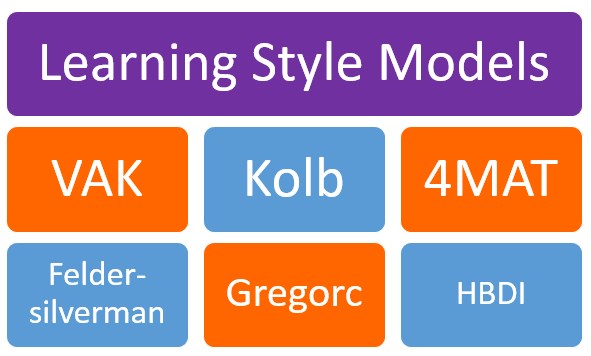Types of Learning Style Models
People learn in different ways. And a learning style is a person’s preferred way of learning.
Each of us has a natural preference for the way in which we prefer to receive, process, and impart information. Because people have preferred ways of learning, much research has went into discovering the different styles. Some models are based on personality types, while others are based on brain dominance.
Over the years several theories and types of Learning Style Models have been developed.
Types of Learning Style Models include:
Felder-Silverman Learning Style
Herrmann’s Brain Dominance HBDI
Left-brain and Right-brain Preferences
Myers-Briggs Type Indicator MBTI
Fleming’s VAK model
Fleming’s VAK (Visual-Auditory-Kinesthetic) model is one of the most common and widely-used categorizations of learning styles. The VAK model provides a simple way to explain and understand learning styles. Fleming believed that there were three categories of learner’s preferences.
Visual – These learners prefer to learn by seeing. They think in pictures. They like visual aids such as overhead slides, diagrams, and handouts.
Auditory – These learners prefer to learn through listening. They like lectures, discussions, and tapes.
Kinesthetic – These learners prefer to learn through experience by moving, touching, and doing. They like active exploration of the world such as science projects, building structures or models, and active experiments.
The Kolb Learning Style Model
Kolb’s learning theory defines four distinct learning styles. These learning styles can be viewed on a continuum across two dimensions, based on how people perceive information (concrete vs. abstract) and process information (active vs. reflective).
Convergers – These learners prefer to learn by solving problems and doing technical tasks, and they are good at finding practical uses for ideas. They like concepts and active experimentation.
Divergers – These learners prefer to learn by observation, brainstorming and gathering information. They are imaginative and sensitive. They like practical experience and reflection.
Assimilators – These learners prefer to learn by putting information in concise logical order, and using reflective observation. They like abstract modeling and theoretical reasoning.
Accommodators – These learners prefer to take a practical, experiential approach. They are people-oriented, hands on learners, who rely on feelings more than logical analysis. They like practical experience and active testing.
The Honey-Mumford Model
Honey Mumford learning styles are very similar to Kolb’s. They also have defined four distinct learning styles.
Activist – These learners prefer challenges brought by new experiences and activities. They dive right into new experience to learn from them. They are great at problem solving and role-playing, and enjoy small group discussions.
Reflector – These learners prefer to learn by watching, thinking about what they have observed. They are cautious people and would start with investigation or observation before making any commitment. They collect and analyze data before making any kind of decision.
Theorist – These learners prefer to think things through step-by-step. They like complex and logical theories as they tend to analyze and synthesize situations, principles, and other processes. They typically prefer listening to lectures, reading, and making models.
Pragmatist – These learners prefer to take what they have learned and apply it to see if it works. They enjoy experimenting or applying theories in practice. They like laboratories, doing field work, and observations.
Felder-Silverman Learning Style Model
The Felder-Silverman Model examines specific areas of personality that contribute to learning. They are active or reflective, sensing or intuitive, visual or verbal, inductive or deductive, and sequential or global. A combination of these styles makes up the individuals learning preferences.
Sensing – These learners prefer concrete thinking, practical, concerned with facts and procedures
Intuitive – These learners prefer conceptual thinking, innovative, concerned with theories and meanings
Visual – These learners prefer visual representations, pictures, diagrams, and flow charts
Verbal – These learners prefer written and spoken explanations
Active – These learners prefer to try things out, working with others in groups
Reflective – These learners prefer thinking things through, working alone or with familiar partner
Sequential – These learners prefer linear thinking, orderly, learns in small incremental steps
Global – These learners prefer holistic thinking, systems thinkers, learns in large leaps
The 4MAT Model
Bernice McCarthy created the 4MAT System. The 4MAT System identifies four learning styles based on brain dominance theory.
Innovative/Imaginative Learners – These learners prefer co-operative learning and brainstorming. They are interested in personal meaning and making connections.
Analytic Learners – These learners prefer lectures and analysis of data. They are interested in acquiring facts in order to deepen their understanding of concepts and processes.
Common Sense – These learners prefer concrete experiential learning activities. They are interested in how things work interested in how things work.
Dynamic Learners – These learners prefer roles-playing and games. They are interested in self-directed discovery and rely heavily on their own intuition.
The Gregorc Model
Anthony Gregorc Model is based on brain hemisphere research. It is based on the existence of perceptions, and falls on a continuum rather than being polar extremes.
Concrete Sequential – These learners prefer order, logical sequence, following directions, predictability getting facts, hands-on activities, step-by-step instructions, and real life examples.
Concrete Random – These learners prefer experimenting to find answers, taking risks, using their intuition, and solving problems independently.
Abstract Sequential – These learners prefer solitude, prefer well-organized material, analyzing situations before making a decision or acting, and applying logic in solving or finding solutions to problems.
Abstract Random – These learners prefer focusing on relationships and their emotions, listening to others, bringing harmony to group situations, establishing healthy relationships with others, focusing on the issues at hand.
Hermann Brain Dominance
The Herrmann Brain Dominant Instrument is a based on the idea that one side of the brain is dominant over the other. The two halves of the brain are then divided into a front and back half, making four sections in the brain. Individuals are dominant in one of these four areas, which is evident by their personality type.
Quadrant A: Left cerebral hemisphere – Theorists (analytical)
Quadrant B: Left limbic system – Organizers (sequential)
Quadrant C: Right limbic system – Humanitarians (interpersonal)
Quadrant D: Right cerebral hemisphere – Innovators (imaginative)
Theorists – These learners prefer lecture, facts, and details, critical thinking, textbooks and readings, etc. They are factually-oriented learner, takes a logical, analytical, quantitative approach to learning tasks
Organizers – These learners prefer to learn by outlining, checklists, exercises and problem solving with steps, policies, and procedures. They learn in a sequential and organized way, and when instructional exercises are structured and detailed.
Humanitarians – These learners prefer brainstorming, metaphors, illustrations and pictures, mind mapping and synthesis, and holistic approaches. They are interpersonal, emotional and kinesthetic.
Innovators – These learners prefer cooperative learning and group discussion, role-playing, and dramatization. They take a holistic approach and are very visual.

